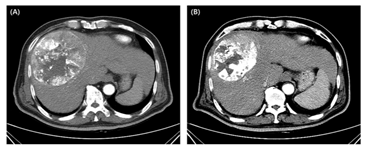글로벌 연구동향
방사선종양학
- [Int J Radiat Biol.] Clinical efficacy of external beam radiotherapy complementing incomplete transarterial chemoembolization for hepatocellular carcinoma
고려의대 / 박선민, 임채홍*
- 출처
- Int J Radiat Biol.
- 등재일
- 2020 Dec
- 저널이슈번호
- 96(12):1541-1549. doi: 10.1080/09553002.2020.1830316.
- 내용
Abstract
Purpose: External beam radiotherapy (EBRT) has been commonly applied as salvage or a combination locoregional modality after transarterial chemoembolization (TACE) for hepatocellular carcinomas (HCCs). This study reports oncologic outcomes and feasibility after application of the two modalities in our center.Methods: Forty consecutive patients who underwent EBRT due to incomplete responses of TACE were evaluated. Fourteen patients (35.0%) received stereotactic body radiotherapy (SBRT) and the remaining patients received conventionally fractionated radiotherapy (RT). A majority of patients who underwent SBRT received doses of 27 to 48 Gy in 3-4 fractions [median EQD2 (Equivalent dose in 2 Gy per fraction radiotherapy): 57.0 Gy]. Conventionally fractionated RT was performed with a median EQD2 of 47.8 Gy.
Results: The median follow-up duration was 14.4 months (range: 2.6-83.0 months). A majority (77.5%) of patients were regarded as having Child-Pugh grade A. The median tumor size was 3.4 cm (range: 0.8-20.1 cm). Ten patients (25.0%) had thrombosis at a main portal branch. The 1- and 2-year overall survival (OS) and progression-free survival (PFS) rates were 82.2% and 42.1% and 55.8% and 32.1%, respectively. The local control rates were 89.1% and 89.1% at 1 and 2 years, respectively. The albumin level was a significant factor affecting OS (p = .002), and the BCLC stage significantly affected PFS (p = .001). Intrahepatic, out-of-field recurrence was the main cause of disease progression (60.0%), and distant metastasis developed in 12 patients (30.0%) during follow-up. Non-classic radiation-induced liver disease was seen in five (12.5%) patients, and two (5%) patients experienced grade ≥3 hepatic toxicities.
Conclusions: EBRT after incomplete TACE was feasible and yielded favorable oncologic outcomes. However, disease progression related to intrahepatic failure remained a hindrance.

incomplete TACE (A) tumor; (B) 방사선치료 후 hypoxic, avascular core에 TACE가 반응한 사례

혈관접근이 불량한 segment 4의 tumor (A, B) 에 방사선치료 후 종양이 관해 (C) 된 사례
Affiliation
Sunmin Park 1 , Won Sup Yoon 1 , Mi Hee Jang 1 , Chai Hong Rim 1
1 Department of Radiation Oncology, Korea University Ansan Hospital, Ansan, Gyeong-Gi Do, Republic of Korea.
- 키워드
- Hepatocellular carcinoma; external beam radiotherapy; liver neoplasm; stereotactic body radiation therapy; transarterial chemoembolization.
- 연구소개
- 경동맥 색전물 (TACE)는 간세포암 치료에 가장 널리 쓰이는 방법이지만, 종양이 크거나 혈관접근이 불량한 암에 대해서는 불완전관해가 종종 발생함. 불완전 반응한 종양은 치료가 어려우나, 방사선치료는 큰 종양의 avascular, hypoxic core나 혈관 접근이 불량한 부위의 종양 등에도 용이하게 치료가 가능함. 금번 연구에서 TACE에 불완전 반응한 종양에 대해 방사선치료 후 완전관해가 37%, 부분관해가 41.3%로 총 반응률이 78%에 이르렀고 국소제어율은 2년간 87%였음. 국소제어율은 대단히 우수했던 반면, out-field recurrence (방사선범위 밖의 간 재발, 60%) 이 많아 systemic agent와의 combination이 필요해보임.
- 덧글달기
- 이전글 [Qual Life Res.] Physical activity status in relation to quality of life and dietary habits in breast cancer survivors: subset analyses of KROG 14-09 nationwide questionnaire study
- 다음글 [Cancers (Basel).] Impact of Radiotherapy on Kidney Function among Patients Who Received Adjuvant Treatment for Gastric Cancer: Logistic and Linear Regression Analyses









